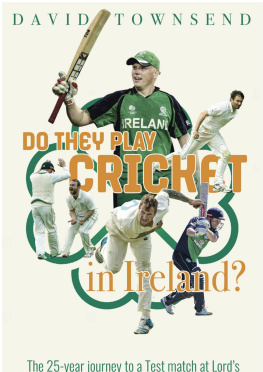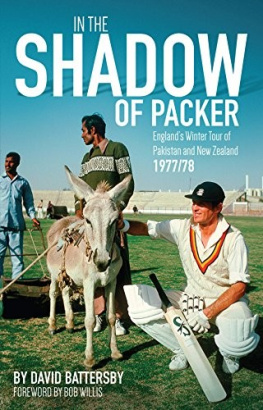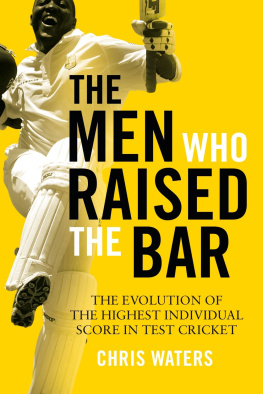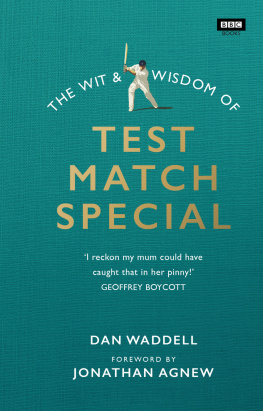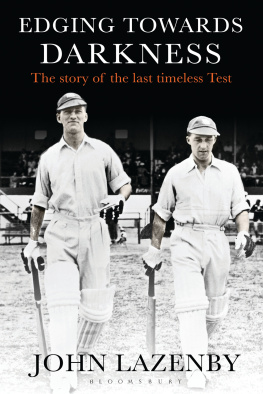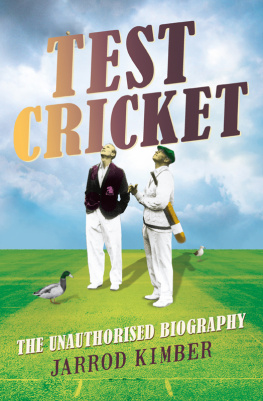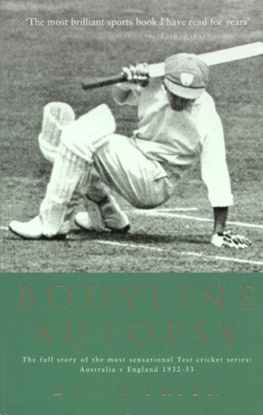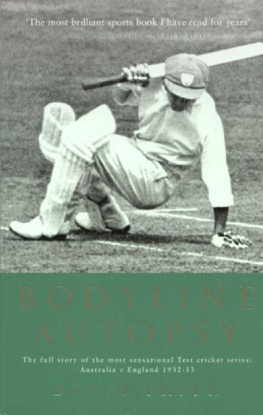STODDYS MISSION
THE FIRST
GREAT TEST
SERIES
18941895
OTHER BOOKS BY DAVID FRITH
Runs in the Family (with John Edrich)
My Dear Victorious Stod
The Archie Jackson Story
The Fast Men
England Australia:
A Pictorial History of the Test Matches Since 1877
Cricket Gallery (ed.)
The Ashes 77 (with Greg Chappell)
Great Moments in Cricket (as Andrew Thomas)
The Golden Age of Cricket 18901914
The Ashes 79
The Illustrated History of Cricket (ed.)
Thommo (with Jeff Thomson)
Crickets Golden Summer (with Gerry Wright)
Rothmans Presents 100 Years England v Australia (ed.)
The Slow Men
England v Australia Test Match Records 18771985
Pageant of Cricket
Guildford Jubilee 19381988
By His Own Hand
STODDYS MISSION
THE FIRST
GREAT TEST
SERIES
1894-1895
DAVID FRITH

ALLEN & UNWIN
in association with

RICHARDI SMART
PUBLISHING
David Frith, 1994
This book is copyright under the Berne Convention.
No reproduction without permission. All rights reserved
First published in 1994
Allen & Unwin Australia Pty Ltd
9 Atchison Street, St Leonards, NSW 2065, Australia
Richard Smart Publishing
6/4 Waruda Street, Kirribilli, NSW 2061
National Library of Australia
Cataloguing-in-Publication entry:
Frith, David, 1937
Stoddys mission.
ISBN 1 86373 802 9.
ISBN 1 86373 780 4 (pbk.)
eISBN 978 1 74269 685 0
1. CricketAustraliaHistory19th century.
2. CricketEnglandHistory19th century. 3. Test matches (Cricket)AustraliaHistory19th century.
4. Test matches (Cricket)EnglandHistory19th century. I. Title.
796.35865
Typeset by Midland Typesetters
All pictures in the book are from the authors collection.
Front cover pictures:
Background, Melbourne Cricket Ground, second Test.
Players, top left to right, Richardson, Briggs, MacLaren, Stoddart, Ward.
All pictures in the book are from the authors collection.
Contents

Preface

No cricket tour book has been delayed as long as this one, and no Test series has better deserved a chronicle in book form. It comes a century after the event.
Stoddys Mission is compiled by one who has always been drawn to the period and has gathered a wide variety of source material, a principal element being the 189495 England captains own original tour scrapbook. Out of it came some rich material for his biographyMy Dear Victorious Stod (l970)in which the 189495 tour occupied no more than 35 pages. The bulky scrapbook, together with a mass of detail from other contemporary newspapers, gleaned by my son, Peter, provided a base for the narrative.
Numerous books and periodicals, studied over many years, have bred in the author a familiarity with those long-lost cricketers which has made it sometimes difficult to adjust to the modern game. The happy consequence is that one who is torn in these two directions can at least enjoy the best of both worlds, the old and the new, even if touches of fantasy sometimes intrude. Further complications spring from the fact of having equal backgrounds in and affinities for both England and Australia.
One reference book warrants particular mention for its value in terms of factual framework, and that is Ray Websters First-Class Cricket in Australia Volume 1 185051 to 194142, which affords an audited scorecard of every match, with many longlasting inaccuracies (even from Wisden) erased. The skills of Patrick Eagar and Jan Traylen in copying rare photographs are also warmly acknowledged. And, not for the first time, Richard Smart, publisher and friend, is thanked for his crucial support and faith.
Stoddys Mission comes with the fervent hope that the 199495 Ashes Test series between Australia and Englandplayed by way of centenary celebration and watched, courtesy of the new-fangled satellite television, by millions rather than thousandswill be just as breathtaking a spectacle as that First Great Test Series when Anglo-Australian cricket combat took recognisable shape.
CHAPTER ONE
The
Build-Up

The first tour of Australia by an English cricket team had taken place 33 years before, in 186162. This was a band of professionals, mostly from Surrey, who were unafraid of seasicknessor, at least, they kept their fear unto themselves as best they couldand keen to pocket the l50 fee together with whatever else they could make by selling bats and other goods that were in short supply in the young colony. The cricketers of New South Wales, Victoria and Tasmania were still far from competent enough to take on the Englishmen on even terms, and all 12 matches with the locals were against teams of 18 or even 22.
Two years after Heathfield Harman Stephensons 186162 pioneering venture, George Parr of Nottinghamshire led the second English team to Australia, having been captain of the very first English overseas tour: to North America in 1859, when the rough Atlantic crossing imposed a reluctance in many of the players ever to risk another sea voyage. Parr, the mighty hitter, triumphantly landed his men in Australia in December 1863 and set about demonstrating English superiority against often feeble opposition in Melbourne, Bendigo and Ballaratwith three weeks in New Zealand halfway through the tourhaving come close to losing his life together with the lives of his precious team when their ship was in collision with another vessel soon after setting out from Sydney to Melbourne. The other vessel sank, and Parr, who for a time was frozen with horror, learned something about English phlegm as his best fast bowler, John Jackson, slept through the pandemonium, having sunk a great deal of ale at the farewell lunch in Sydney, while George Tarrant, another ferocious fast bowler (who caught boy Spofforths imagination), was so overcome by panic that he jumped into a lifeboat which was being lowered to save drowning passengers from the other ship.
Australia at last got sight of the monarch of the game, Dr WG Grace, then aged 25, when he accepted Melbourne Cricket Clubs invitation to take out a team in 187374. Recently married, WG made this an extended honeymoon, and after a couple of early losses, the Englishmen won consistently, though more easily against the local teams of 15 than 18. Grace had a fair idea of the strengthor more accurately the weaknessof Australian cricket as the two preceding English teams had found it, but by the end of the tour he was prepared to acknowledge that standards were rising. These tours were helping to establish cricket as Australias national summer game, and the influx of immigrants who played and the settling in Australia of top players Charlie Lawrence and Billy Caffyn, who coached widely and wisely, launched an attitude and a passion which would eventually take Australia to the pinnacle of world cricket.


